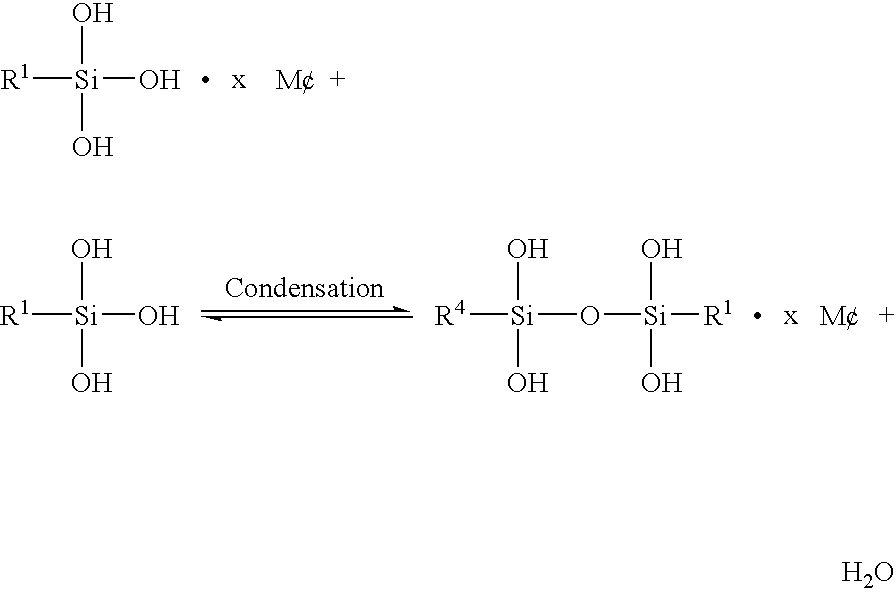Hydrophobic and Lyophobic Coating
a technology of hydrophobic coating and lyophobic coating, applied in the field of coatings, can solve the problems of poor adhesion of fluorocarbon compounds to surfaces, adverse environmental effects, and high cost of fluorocarbon compounds
- Summary
- Abstract
- Description
- Claims
- Application Information
AI Technical Summary
Benefits of technology
Problems solved by technology
Method used
Image
Examples
example 1
[0150]In this example, a superhydrophobic and lyophobic coating was applied to various fabrics as described below.
[0151]A variety of coating compositions were prepared as described below.
[0152]The ingredients used to form the coating compositions are set out below:[0153]10 g methyltrimethoxysilane[0154]0.5-10 g 1H,1H,2H,2H-perfluorooctyltriethoxysilane[0155]0.01-0.1 g dibutyltin dilaurate[0156]0.01-0.2 g 3-aminopropyltriethoxysilane[0157]60 mL ethyl acetate
[0158]A variety of coating compositions were prepared using the above ingredients in amounts within the ranges specified above. The coating compositions were prepared as follows: The methyltrimethoxysilane, 1H,1H,2H,2H-perfluorooctyltriethoxysilane, dibutyltin dilaurate and ethyl acetate were stirred at 60° C. for 3 hours. The resultant composition was then blended with 3-aminopropyltriethoxysilane to form the coating composition.
[0159]The coating compositions were then applied to various fabrics. The fabrics used were a pure wool...
example 2
[0169]In this example, a superhydrophobic and lyophobic coating was applied to various fabrics as described below.
[0170]A variety of coating compositions were prepared as described below.
[0171]The ingredients used to form the coating compositions are set out below:[0172]10 g methyltrimethoxysilane[0173]0.1-1 g hydroxy terminated polydimethylsiloxane (50,000 cst)[0174]0.5-10 g 1H,1H,2H,2H-perfluorooctyltriethoxysilane[0175]0.01-0.1 g dibutyltin dilaurate[0176]0.01-0.2 g 3-aminopropyltriethoxysilane[0177]60 mL ethyl acetate
[0178]A variety of coating compositions were prepared using the above ingredients in amounts within the ranges specified above. The coating compositions were prepared as follows: The methyltrimethoxysilane, polydimethylsiloxane, 1H,1H,2H,2H-perfluorooctyltriethoxysilane, dibutyltin dilaurate and ethyl acetate were stirred at 60° C. for 3 hours. The resultant composition was then blended with 3-aminopropyltriethoxysilane to form the coating composition.
[0179]The coat...
example 3
[0189]The effect of the solvent used during the formation of hydrophobic nano-sized particles by Reaction 1 on the hydrophobicity of the resultant coating is illustrated in the following example.
[0190]Two coatings were prepared using coating compositions A and B. The ingredients used to form the coating composition A are set out below:[0191]10 g methyltrimethoxysilane[0192]2 g 1H,1H,2H,2H-perfluorooctyltriethoxysilane[0193]0.05 g dibutyltin dilaurate[0194]0.1 g 3-aminopropyltriethoxysilane[0195]60 mL ethyl acetate
[0196]The coating composition was prepared as follows: The methyltrimethoxysilane, 1H,1H, 2H, 2H-perfluorooctyltriethoxysilane, dibutyltin dilaurate and ethyl acetate were stirred at 60° C. for 3 hours. The resultant composition was then blended with 3-aminopropyltriethoxysilane to form the coating composition.
[0197]The coating composition was then applied to a piece of superfine wool fabric by dipping the fabric into the coating composition.
[0198]Coating composition B was ...
PUM
| Property | Measurement | Unit |
|---|---|---|
| particle size | aaaaa | aaaaa |
| contact angle | aaaaa | aaaaa |
| contact angle | aaaaa | aaaaa |
Abstract
Description
Claims
Application Information
 Login to View More
Login to View More - R&D
- Intellectual Property
- Life Sciences
- Materials
- Tech Scout
- Unparalleled Data Quality
- Higher Quality Content
- 60% Fewer Hallucinations
Browse by: Latest US Patents, China's latest patents, Technical Efficacy Thesaurus, Application Domain, Technology Topic, Popular Technical Reports.
© 2025 PatSnap. All rights reserved.Legal|Privacy policy|Modern Slavery Act Transparency Statement|Sitemap|About US| Contact US: help@patsnap.com



